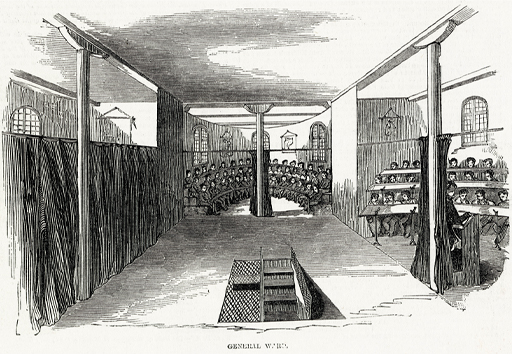2 What was taught in the prison school
Between 1820 and 1850, the curriculum (skills and subjects) taught in prisons expanded.
Initially, prisoners in many institutions were taught only to read, primarily in order to read the Bible. Soon, instruction in writing was added. By 1850, schools in a large proportion of local prisons and in all convict prisons and on prison hulks were teaching basic arithmetic. At the same time, reports from some local prisons and from all convict institutions indicate that lessons in other subjects, notably geography and history, had been added. Women and girls sometimes received instruction in sewing or knitting as well.
In terms of reading, writing and arithmetic there was increasingly little difference between what men and women, adults and children were taught, at least officially (Crone, 2022, ch.4). In its essentials, the curriculum of the prison school largely reflected that of British and Irish elementary schools outside.

Nonetheless, there were a number of important differences. In local prisons at least, the curriculum expanded and contracted according to institutional circumstances – for example, the departure of a teacher, or the appointment of a new teacher who could not teach parts of the curriculum might mean that prisoners were denied lessons they formerly enjoyed. Many prisoners in local prisons who arrived unable to read and so had to start from scratch were never given lessons in history or geography because their sentences were too short – there just wasn’t enough time. For example, 165 prisoners (132 males and 33 females) were permitted to attend school at Lewes House of Correction in 1846. But only 17 of them, all men, who could already read when committed, received lessons in geography (Gaol Act Reports, 1847, p. 228).
At some local prisons, officials used access to different parts of the curriculum as a way to incentivise prisoners. Only the ‘well conducted’ at Swaffham House of Correction in 1851 were allowed the ‘privilege’ of instruction in writing and arithmetic (Inspectors, Northern & Eastern, 17th Report, 1852–53, p. 70). Prisoners wanted to learn to write in order to communicate with loved ones through letters. Instruction in arithmetic was prized, mainly by boys, because it offered a different mental exercise. In the eyes of the prison authorities, both writing and arithmetic threatened to make the curriculum too secular (non-religious).
